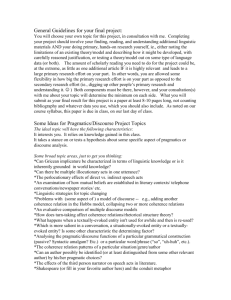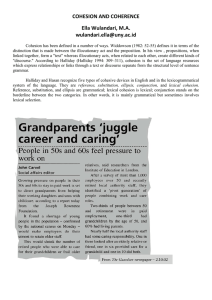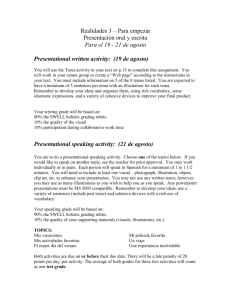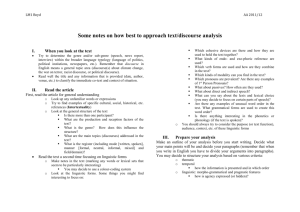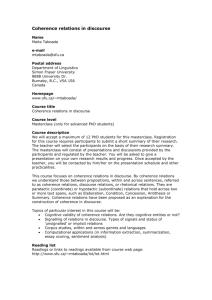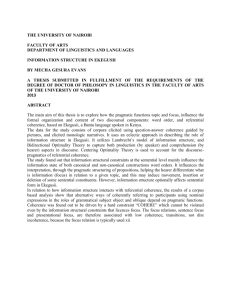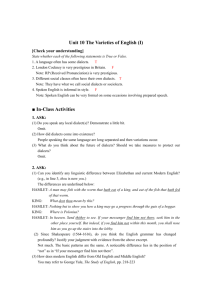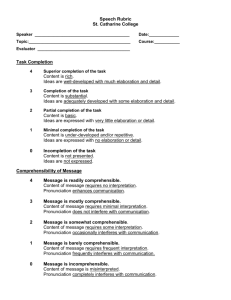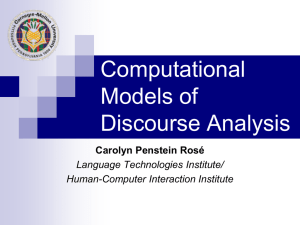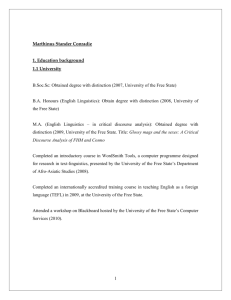Introduction to Linguistics 8 Written Language
advertisement
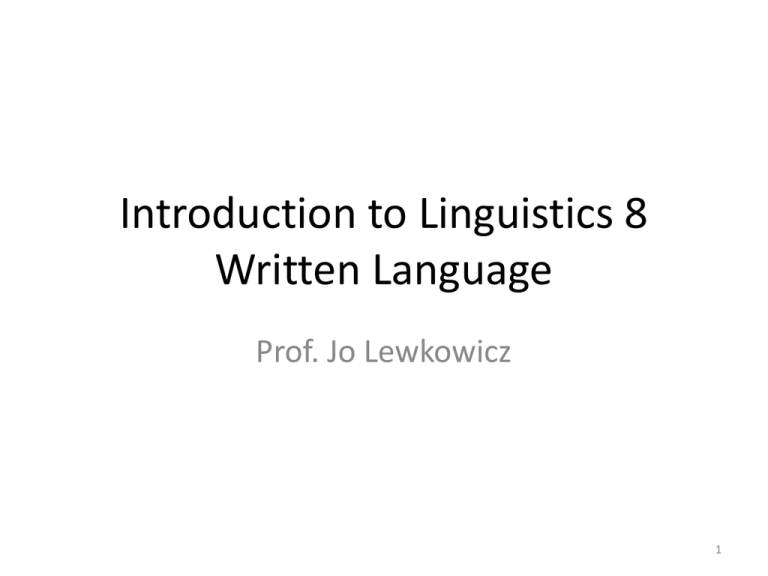
Introduction to Linguistics 8 Written Language Prof. Jo Lewkowicz 1 Review 1. What do you understand by co-construction of meaning? 2. List 4 potential causes of misunderstanding in normal conversation. 3. Why do we often use indirect speech? What factors determine whether we ask someone to do us a favour directly or indirectly? 4. What is the locuctionary aspect, illocutionary force and perlocutionary effect of the following exchanges: A: This could do with more sugar. B: Here you are. C: This could do with more sugar. D: Why do you say so? Speech acts 1. What are speech acts? 2. Match the following utterances to the speech act type. (Speech act types: directive, commissive, representative, performative, expressive) 1. 2. 3. 4. 5. 6. 7. 8. 9. 10. What a terrific party! I want to apologise for my behaviour last night. The coffee pot is empty. Don’t worry, I’ll be there by ten. I went to the movies on Saturday. Pass me the matches. I’m really proud of your success! War is hereby declared. Darwin’s theory is at least partially correct. I’ll pay you back tomorrow. 3 Context and language use • Context has an important effect on the type of discourse produced. • Aspects of context that may affect discourse include: – Purpose of utterance – Mode of communication (face-to-face, texting, telephoning) – Gender of the interlocutors (males only, females only, mixed company) – Topic being discussed – Relationship between speakers 5 Similarities between speech & writing • Both serve the same 3 basic purposes: – Transactional: public signs in the street, instruction manuals, labels on food packaging, maps, TV programmes, maps, newspapers and magazines, etc. – Interpersonal: letter, email, postcards, diaries – Aesthetic: novels, comics, movie/play scrpts, poems • Can view speech and writing lying on a continuum: writing is not speech written down. Differences between speech and writing • Speech – All languages exist in spoken form – Acquired – 40 sounds in English – ‘Disappears’ if not recorded – Less dense – May be fragmentary & ungrammatical • Writing – Not all language exist in written form – Learned – 26 letters in English – Permanent record – More content to function words – More coherent, with complete sentences Aspects of written English • Text connectivity is achieved through a number of features in written English: – End focus: providing new/ important information towards the end of clauses/sentences and building on information that has been provided. – Subordination of ideas • Compare: – Although he appeared to be a nice man, he turned out to be a thief. – Although he turned out to be a thief, he appeared a nice man. – Cohesive devices (ties) Cohesion • Cohesion: linguistic links between clauses and sentences that mark various types of relationships • Types of cohesive ties: – Reference – Substitution – Ellipses – Conjunction – Lexical 9 Reference • Personal: – My grandfather died last year. He was 84. • Demonstrative – George W. Bush wanted to seem tough and decisive. This only happened among his conservative constituents. • Comparative – A: Would you like this seat. – B: No thanks, I’d prefer the other one. 10 Substitution • Nominal – Could you pass me another pencil. This one is broken. • Verbal – A: I saw the new Scorsese film last week. – B: So did I. • Clausal – A: Are you going to the game on Saturday? – B: I think so. 11 Ellipses • Nominal – A: I want the white wine. – B: I prefer the red. • Verbal – A: Have you ever skied? – B: Yes, I have. • Clausal – A: Mike and Sandy are going to Bangkok for Christmas. – B: Yeah? They didn’t tell me. 12 Conjunctions • Adversative – There’s a typhoon on the way. However, they don’t expect a direct hit. • Additive – There’s the coffee pot. And there’s the tea if you prefer. • Temporal – Brick tea is a blend that has been compressed into a cake. First, it is ground to a dust. Then it is usually cooked in milk. • Causal – A: Why did you turn the TV off? – B: Because I cannot stand all those reality shows. 13 Lexical • Repetition – A: What sort of novel are you looking for? – B: I’m looking for a novel that won’t put me to sleep. • Synonym – You could try reversing the car on the slope. The incline isn’t all that great. • Antonym – You say stop. I say go. • Hyponym – A: Would you like some papaya or mango? – B: Piece of each. I love tropical fruit. • Collocation – All that plants need for a healthy life are sunlight, fertilizer or other nutrients, and water. 14 Text coherence • What is the problem with the following text? When Anthony Burgess married for a second time, it was to a woman from Malta. Marriage as an institution reinforces traditional values. We have several institutions in our street. The street was recently closed for the cable television company to carry out much needed repairs. I don’t have cable tv but I’m thinking of getting it. 15 Coherence • Coherence: the extent to which discourse is perceived to ‘hang together’ rather than being a set of unrelated sentences or utterances. Coherence is a psycholinguistic rather than a linguistic phenomenon. In other words, it exists in the mind of the listener or reader rather than on the page. Register • Register- the kind of language used by particular discourse communities for communicative purposes • Register described in terms of 3 aspects of language: – Field: the subject of the communication, e.g. opera, tennis, medicine – Tenor: the relationship between the interactants; discourse is different if a doctor is talking to another doctor or if she is talking to a patient – Mode: the means of communication, e.g. written/spoken, affects the feedback possible during the discourse process. 17 Register and meaning • Field: what? – how the text hangs together experientially and logically – ideational • Tenor: who? – how the text hands together interpersonally – interpersonal • Mode: how? – how the text hangs together textually – textual 18 Genre • Genre: a purposeful, socially constructed written or oral text such as a narrative, a casual conversation, a poem, a recipe. Each genre has its own characteristic structure and grammatical forms that reflect its social purpose. • Genre analysis considers text patterns that go beyond the sentence. • Purpose of text will determine its internal structure, e.g. recount, explain, report, inform • Texts have their own lexis and grammar, e.g. recipes have own layout, written as a set of instructions and with words associated with cooking , e.g. al dente, medium-rare, etc. 19 Reorder these sentences to make a paragraph 1. He remembered when Hariett had come home with the clock, how she had crossed the hall to show it to Arlene cradling the brass case in her arms and talking to it through the tissue paper as if it were an infant. 2. The air was already heavy and vaguely sweet. 3. Bill took a deep breath and entered the Stones’ apartment. 4. The sunburnt clock over the television said half past eight. 20 Identify and name the cohesive devices 1. Peace in the Middle East is a cherished dream. However, few people expect to see this in their lifetime. Conflict appears to be a sad reality in the region. 2. Two special Miro exhibitions were held in Barcelona recently. The first exhibition is of his early work. The other exhibition is of his later work. Most viewers prefer the later one, as do most of the critics. However, a minority of Miro critics prefer the former. This is causing something of a controversy in art circles. 21
